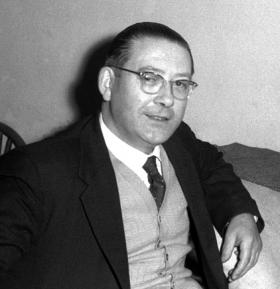National Folklore Collection celebrates its 75th birthday
Published in 20th-century / Contemporary History, Issue 3 (May/June 2010), News, Volume 18
Seán Ó Cróinín, who worked as a full-time collector for the Commission from 1938 until 1965 in most parts of County Cork. (National Folklore Collection, UCD)
The Irish Folklore Commission, now the National Folklore Collection, was the first state-funded body to employ full-time collectors of folklore in the field. It is one of the world’s best and largest folklore collections. Owing to the interest of Scandinavian scholars of old and modern Irish and of Irish folklore, the influence of people such as Carl von Sydow, Reidar Christiansen and Ake Campbell was evident in the Commission’s foundation. Its mission and vision were inspired by its honorary director, James Hamilton Delargy.
The Commission was devoted to the collection and preservation of oral tradition and ethnology. Folklore collectors were frequently accompanied by foreign scholars. Some of the better-known collectors included Seán Ó hEochaidh in Donegal, Tadhg Ó Murchú and Seosamh Ó Dálaigh in Kerry, Michael J. Murphy in counties Tyrone, Armagh, Louth and Derry, and Seán Ó Cróinín in Cork. Theirs was not an easy task. A number of full-time collectors left pensionable employment and devoted themselves for decades to collecting folklore. The Commission’s future was at times uncertain. Much of the work by full-time collectors took place at night, when entertainment followed the day’s work. Long nights of collecting were followed by days of transcribing the previous night’s harvest, which the collectors then forwarded to the Dublin office of the Commission. Full-time collectors were required to write a journal on a daily basis, documenting their day-to-day work. It was perceived that music and song were in need of special attention, and two full-time collectors were appointed to this area: Liam de Noraidh and Séamus Ennis.
The Commission developed a number of highly productive collecting schemes, including the appointment of part-time collectors throughout Ireland. Thousands of schoolchildren were involved in the ‘Schools’ Collection’, 1936–7—one of the most popular and most frequently consulted sections of the National Folklore Collection. It was imperative to document the tradition in the broadest way possible. A major contribution was made by questionnaire correspondents. These voluntary contributors responded via postal questionnaires on particular aspects of Irish tradition, including subjects such as ‘The Great Famine’, ‘Vernacular Housing’, ‘Holy Wells’, ‘Emigration’ and ‘St Martin’s Day’. Although primarily a manuscript archive from its inception, the Commission also saw the need to make sound recordings and to create a photographic record. Its specialist library attracts many scholars and researchers.
The Irish Folklore Commission is part of a wider history and fits into the international and national development of folklore studies. The early state sought a ‘true’ identity and the Commission’s quest for local and regional folklore was perceived as providing a strong element of this identity. Housed in the Newman Building, Belfield, the National Folklore Collection, a public archive, is today one of the finest of its kind, consulted by hundreds of researchers and other visitors each year. It consists of manuscripts, audio, film and video recordings, a specialist library, photographs, drawings and paintings. The work of the Irish Folklore Commission merits recognition, and a series of events have been organised to commemorate a remarkable cultural achievement during the first half of the twentieth century, in a time of acute economic need, by one of the most innovative government-funded bodies in western Europe. HI
Ríonach uí Ógáin is Director of the National Folklore Collection, University College Dublin.
http://www.ucd.ie/irishfolklore
















